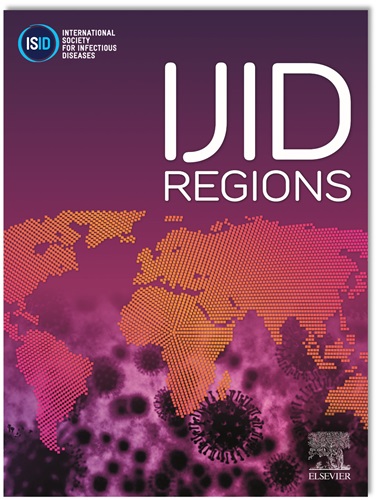Progress on implementation of the World Health Organization global antimicrobial resistance surveillance system recommendations on antimicrobial resistance surveillance in Africa: Findings of preliminary analysis of a scoping review
IF 4.8
2区 医学
Q1 INFECTIOUS DISEASES
引用次数: 0
Abstract
Introduction
Antimicrobial resistance (AMR) is a significant global health concern, especially impacting low- and middle-income countries. The World Health Organization (WHO) global antimicrobial resistance surveillance system (GLASS) was rolled out in 2016 to guide AMR surveillance systems. However, its implementation has not been fully evaluated. We conducted a scoping review of the current status of implementation of GLASS and present preliminary findings.
Methods
We developed a search strategy and retrieved articles conducted between January 2016 and November 2023 from four electronic databases (MEDLINE, SCOPUS, CINAHL, and Embase). We followed the Arksey and O'Malley's methodological framework for scoping reviews to guide analysis and reporting. We extracted data on priority samples, pathogens, pathogen-antibiotic combinations and assessed compliance to WHO GLASS recommendations on AST and AMR surveillance.
Results
7477 articles were identified, 6868 duplicates and irrelevant articles were removed at abstract screening, and 609 studies were included for the full-text review, of which 344 were considered for data extraction. Of the 344 studies, 38/344 (11%) were included in this analysis. Majority of studies were conducted in Eastern 50% (19/38), followed by Western 34% (13/38) and Northern 16% (6/38), Africa. 95% (36/38) of studies were conducted in hospital settings. Majority 92% (35/38) of the studies involved only one priority sample type (blood 46% (16/35); urine 32% (11/35) and stool 23% (8/35); while 8% (3/38) studies involved the collection of two priority sample types, specifically urine and blood. Of the 19 studies that focused on blood as a priority sample type, 8 (42%), 11 (58%), 13 (68%), 10 (53%), 1 (5%) and 5 (26%) recovered Acinetobacter baumannii, Escherichia coli, Klebsiella pneumoniae, Staphylococcus aureus, and Salmonella species respectively. Shigella and Salmonella species were recovered from 6 (75%) and 7 (88%) of the 8 studies that focused on stool. Escherichia coli and Klebsiella pneumoniae were also recovered from 11 (79%) of the 14 studies that focused on urine. Compliance to GLASS priority pathogen-antibiotic combinations was 13% (1/8), 9% (1/11), 8% (1/13), 70% (7/10), and 60% (3/5) of the studies that recovered Acinetobacter baumannii, Escherichia coli, Klebsiella pneumoniae, Staphylococcus aureus, and Salmonella species from blood respectively. 17% (1/6) and 29% (2/7) of the studies that recovered Salmonella and Shigella species from stool followed the GLASS priority pathogen-antibiotic combinations for AST. None of the studies on urine followed the GLASS-recommended pathogen-antibiotic combination.
Discussion
Africa has made progress in implementing the GLASS recommendations. However, adoption of GLASS recommendations including appropriate pathogen-antibiotic combinations for priority pathogens and samples, varied across countries. This limits a standardisation and comparability of data.
Conclusion
Gaps exist in AST for AMR surveillance with priority pathogen-antibiotic combinations not routinely tested in most surveillance programs. A full report from this study will be published by June 2024.
实施世界卫生组织全球抗菌素耐药性监测系统关于非洲抗菌素耐药性监测的建议的进展:范围审查的初步分析结果
抗菌素耐药性(AMR)是一个重大的全球卫生问题,尤其影响到低收入和中等收入国家。世界卫生组织(世卫组织)全球抗菌素耐药性监测系统(GLASS)于2016年推出,以指导抗菌素耐药性监测系统。然而,其执行情况尚未得到充分评价。我们对GLASS的实施现状进行了范围审查,并提出了初步调查结果。方法采用检索策略,从MEDLINE、SCOPUS、CINAHL和Embase四个电子数据库中检索2016年1月至2023年11月发表的文章。我们遵循Arksey和O'Malley的方法框架来划分审查范围,以指导分析和报告。我们提取了关于重点样本、病原体、病原体-抗生素组合的数据,并评估了遵守世卫组织GLASS关于AST和AMR监测建议的情况。结果摘要筛选共筛选到7477篇文献,剔除重复及无关文献6868篇,共纳入609篇文献进行全文综述,其中344篇纳入数据提取。在344项研究中,38/344(11%)纳入本分析。大多数研究在非洲东部50%(19/38)进行,其次是西部34%(13/38)和北部16%(6/38)。95%(36/38)的研究在医院环境中进行。92%(35/38)的研究只涉及一种优先样本类型(血液46% (16/35);尿液32%(11/35),粪便23% (8/35);而8%(3/38)的研究涉及两种优先样本类型的收集,特别是尿液和血液。在将血液作为优先样本类型的19项研究中,分别有8项(42%)、11项(58%)、13项(68%)、10项(53%)、1项(5%)和5项(26%)研究回收了鲍曼不动杆菌、大肠杆菌、肺炎克雷伯菌、金黄色葡萄球菌和沙门氏菌。8项以粪便为重点的研究中分别有6项(75%)和7项(88%)检出志贺氏菌和沙门氏菌。在14项针对尿液的研究中,有11项(79%)也检出了大肠杆菌和肺炎克雷伯菌。在从血液中回收鲍曼不动杆菌、大肠杆菌、肺炎克雷伯菌、金黄色葡萄球菌和沙门氏菌的研究中,GLASS优先病原菌-抗生素联合用药的依从性分别为13%(1/8)、9%(1/11)、8%(1/13)、70%(7/10)和60%(3/5)。从粪便中回收沙门氏菌和志贺氏菌的研究分别有17%(1/6)和29%(2/7)遵循了GLASS推荐的AST病原体-抗生素组合,而尿液中没有一项研究遵循GLASS推荐的病原体-抗生素组合。讨论非洲在执行《GLASS》建议方面取得了进展。然而,各国采纳GLASS建议的情况各不相同,包括针对重点病原体和样本采用适当的病原体-抗生素组合。这限制了数据的标准化和可比性。结论AST在AMR监测中存在ap,但在大多数监测项目中未常规检测优先病原体-抗生素组合。该研究的完整报告将于2024年6月发布。
本文章由计算机程序翻译,如有差异,请以英文原文为准。
求助全文
约1分钟内获得全文
求助全文
来源期刊
CiteScore
18.90
自引率
2.40%
发文量
1020
审稿时长
30 days
期刊介绍:
International Journal of Infectious Diseases (IJID)
Publisher: International Society for Infectious Diseases
Publication Frequency: Monthly
Type: Peer-reviewed, Open Access
Scope:
Publishes original clinical and laboratory-based research.
Reports clinical trials, reviews, and some case reports.
Focuses on epidemiology, clinical diagnosis, treatment, and control of infectious diseases.
Emphasizes diseases common in under-resourced countries.

 求助内容:
求助内容: 应助结果提醒方式:
应助结果提醒方式:


